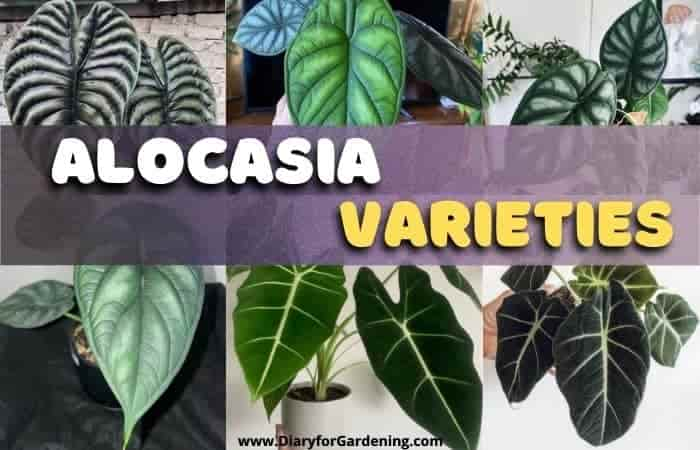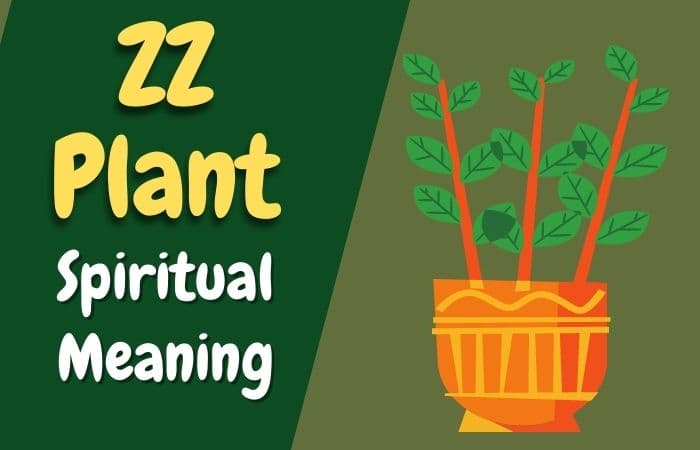Alocasia vs Colocasia? Differences & Similarities to identify
The main differences between alocasia and colocasia is, alocasia leaves are in the horizontal direction. The leaf stems or petioles are seen to be extended into the leaves. That’s why most Alocasia leaves tend to point upward. In contrast, the Colocasia petioles connect down from the notches in the leaves. That’s why leaves are seen to drop or hang downward.
Both Alocasia and Colocasia are extremely beautiful. Both are from the family of ‘Araceae’ and both are very popular houseplants. They both have very large leaves and they are mostly known as ‘elephant ear’ and both are very amazing plants.
People often get confused with them because of their similar appearance. The appearance of the leaves and color of these two plants are almost similar which make people confused. But actually it’s not too difficult to separate them.
They have some distinct differences that distinguish the species from each other. But they have some similarities also.
In this article, we will discuss the differences between Alocasia and Colocasia varieties and also we will show some similarities between them so that you can easily identify each one.
Alocasia vs Colocasia: What is the Difference?
The main difference between the two plants is in the leaf characteristics.
Alocasia leaves are very glossy or waxy in appearance with prominent veins. They are more arrow-shaped or heart-shaped; while Colocasia has matte green leaves and the leaves are more or less round in shape.
Alocasia leaves are sometimes but not always smaller than Colocasia leaves.
Colocasia can tolerate wetter soil than any other species. It can be found growing in wet soil and standing water. On the other hand, Alocasias cannot grow in standing water. It grows under normal garden conditions with a consistent moisture supply.
Overview of Alocasia and Colocasia
Alocasia and Colocasia both plants are known as ‘elephant ears’. They belong to the same family of ‘Araceae’. Both the plants are very popular for their large leaves, for which they are known as elephant ears.
Both plants are great tropical-looking plants and very easy to grow. They can be grown in colder climates where such large growth is hard to come by.
Alocasia is a perennial in U.S. Department of Agricultural plant hardiness zones 8b to 11. And Colocasia is a perennial in USDA plant hardiness zones 8 to 11. Both have almost identical growing zone.
These two plants have many similarities as they belong to the same family. But they also have some striking differences that distinguish them from each other.
Alocasia grows well in shaded or partial sun and in well-drained soil. Full sun exposure or warm areas can be harmful for this plant.
On the other hand, colocasia grows best in the sunlight and in lands with ample water.
Both the plants are native to tropical southern Asia, Indonesia, Malaysia, New Guinea, and some parts of Australia or the Pacific Island. As they are from the same family they have many similarities because of this it creates confusion between Alocasia and Colocasia.
Why Are they called “Elephant Ear”?
Alocasia and Colocasia both plants are called elephant ears by gardeners. They are called elephant ears because their leaf shapes are like the ear of the elephants.
The term ‘elephant ear’ is the common name for the group of tropical perennial plants or a variety of plants in the genus Colocasia and Alocasia. These plants are grown for their large, heart-shaped leaves.
These elephant ear plants also have been hybridized to produce various-sized leaves and green, blue, black range in colors. These plants are mostly grown for their leaves but they also bloom with an arum-like flower.
Wanna Buy Colocasia? Click Here.
Why identification matter?
Botanical curiosity is the main reason to find out the true identity of a plant. Though Alocasia and Colocasia have many similarities, they have many differences.
The leaves of Alocasia are held horizontally with the tips pointed and they are upward growing. They have a shiny leaf surface and a more elongated corm.
On the other hand, Colocasia leaf tips point downward. They have rounded, bowling ball shaped corm.
Alocasia has the petiole connected at the leaf notch whereas Colocasia has the petiole connected to the leaf down from the notch.
You can also take a look at Philodendron Paraiso Verde Care.
Important differences which help them identify properly are given below:
Alocasia Plant
Alocasia is most often grown as houseplants but they are also brought outdoors during the warm months. They are stunning tropical plants with arrowhead –shaped leaves and shiny surfaces.
Alocasias are broad-leaved, rhizomatous, or tuberous flowering plants. There are 97 species in this genus and they are native to tropical and subtropical Asia and eastern Australia.
Alocasia plants are popular for their stunning foliage feature that can become the centerpiece of a garden or room.
It is a very fast growing plant. There are some species of Alocasia which are invasive. It varies according to the location. It is seen especially in the gulf coast of the United States. It should be avoided if you have children or pets in the house as it is toxic to humans and animals.
Alocasia is the botanical name of this plant. These popular houseplants go by some common names. It is also known as elephant ear, African mask. All these names refer to the same plants.
The leaves of Alocasia are attached to the base of the stem. They are upward facing Elephant ears. A warm, bright area is required. They are slightly shade tolerant but they can also grow well in the full sun.
Primarily, the foliage of this plant is dark green and when they grow up they are seen almost black with a silvery sheen and some have yellow veins in them.
The leaves are edible but sometimes they are irritating for the skin as they contain needle-like crystals of calcium oxalate. They must be cooked first if they are wanted to be a food.
They also increase the beauty of the garden because of their araceous flowers which grow at the end of the short stalk. But the flowers are not always conspicuous. They are often hidden behind the leaf petioles. They also produce cone-like clusters of red-berried fruits which are edible.
Cold winters or dryness are harmful for the survival of Alocasia plants. They appreciate extra humidity and prefer part shade and well-drained soil.
Products Mentioned in the article-

Glass Spray Bottle
- Small Size with Large Capacity
- Multi Purpose
- Comfortable design

LEVOIT Humidifier
- Smart & Voice Control
- 40- hours mist
- Made for small room
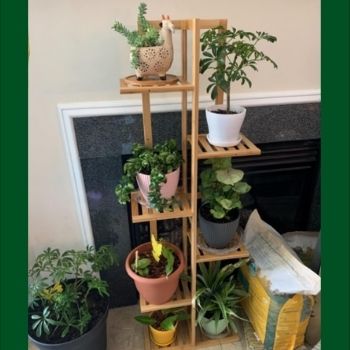
Bamboo Plant Stand Rack
- 6 Layers Plant Stand
- Multi-purpose
- Eco-Friendly Varnish Surface
Colocasia Plant
Colocasias are tropical perennial plants that are mostly known as elephant ear or taro. They are the most common plants in the western world.
Colocasia is also a genus of the Araceae family. They are native to Southeastern Asia and Indian subcontinent. They have been cultivated in Asia and Polynesia for thousands of years and they are selected for their ornamental characteristics.
The leaves of Colocasia are plain old green elephant ears which are more or less rounded, bowling ball shaped, and corm. Colocasia leaves are very large in size and they tend to point downward. The leaves are arrow or heart-shaped and they have prominent veins.
The petioles of Colocasia are connected down from the notches in the leaves and it enables the leaves to drop or hang at the downward angle.
Colocasia plants require full sun for the best growth. Compost-rich soil is best for the Colocasia plants and the soil should not be wet in the wintertime. They require lands with ample water.
Colocasia is actually a food crop. It is grown commercially in Hawaii and they are also found in Asian markets. The Tubers of Colocasia are a very popular food. They can be cooked down into a starchy edible paste called “poi”.
There are different varieties of Colocasia like black-leaved Colocasia, black-spotted, glossy and matte-leaved varieties. But their foliage is primarily green.
The flowers of Colocasia are usually yellow and they are paired with white fruits or berries.
Some Varieties of Alocasia and Colocasia
| Alocasia varieties | Colocasia varieties |
| Alocasia Amazonica ‘polly’ | Colocasia esculenta ‘Diamond Head’ |
| Alocasia Macrorrhizos ‘Giant Taro’ | Colocasia esculenta ‘Elena’ |
| Alocasia Baginda ‘Silver Dragon’ | Colocasia esculenta ‘Elepaio’ |
| Alocasia Zebrina | Colocasia esculenta ‘Hawaiian Eye’ |
| Alocasia ‘Dragon Scale’ | Colocasia esculenta ‘Hilo Bay’ |
| Alocasia Macrorrhiza ‘Stingray’ | Colocasia esculenta ‘Lime Aide’ |
| Alocasia Longiloba | Colocasia esculenta ‘Maui Magic’ |
| Alocasia Cuprea ‘Red Secret’ | Colocasia esculenta ‘Mojito’ |
| Alocasia cucullata ‘Hooded Dwarf’ | Colocasia esculenta ‘Pineapple princess’ |
| Alocasia Micholitziana “Frydek’ | Colocasia esculenta ‘Pink China’ |
| Alocasia Reginula ‘Black Velvet’ | Colocasia esculenta ‘Rhubarb’ |
| Alocasia Wentii | Colocasia esculenta ‘Burgundy Stem’ |
If you are interested in Alocasia varieties you can get more detailed information Read here.
Differences between Alocasia and Colocasia
Alocasia and Colocasia have many similarities. But there are actually some recognizable differences too between these two beautiful plants. Now we will discuss the differences.
Leaves difference
The main difference between these two plants is in the leaf characteristics. Though both plants have very large leaves and both are called elephant ear, they have distinct differences in their leaves. Sometimes, the leaves of Alocasia are smaller than the leaves of Colocasia. For identifying them properly checking the leaves is the quickest method.
Shape
The leaves of Alocasia are upward-facing and they are seen to stand in a horizontal direction. The shape of leaves can vary from slim arrowheads to wide heart-shaped leaves. Every new leaf can be twice the size every week.

On the other hand, the Colocasia leaves tend to point downward. They are more or less rounded, bowling ball-shaped.
Texture
The leaves of Alocasia have a shiny surface with an extended corm. They are thick, waxy, slick and glossy in texture. Alocasia leaves are attached to the base of the stem rather than in the center.
The Colocasia leaves have a matte finish. They are attached to the center of the stem.

Color
The foliage of Colocasia is predominantly green in color. But they have plenty of variation. There are black-leaved Colocasia, black-spotted, glossy, matte-leaved varieties.
The leaves of Alocasia are primarily dark green but they are also seen in shades of almost black with a silvery sheen.
If the leaves are seen to be point up then the plant is probably Alocasia. Whereas, it the leaves point down then it is probably a Colocasia. This is a visual distinction which makes it easy to distinguish these two plants.
Petioles
There is also a visible distinction in the petioles. Because of this, the leaves of these two plants are the most obvious difference.
The petioles of Alocasia extend into the leaves and because of this the leaves follow the line of the petioles. So, most Alocasia leaves tend to point upward.
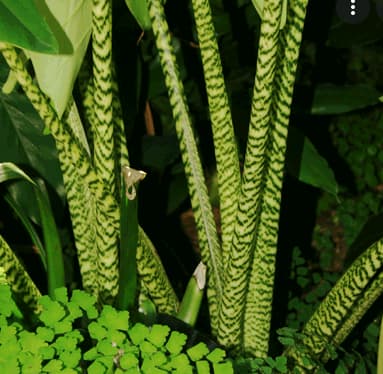
On the other hand, the petioles of Colocasia connect down from the notches in the leaves. That’s why the leaves are seen to hang or drop at a downward angle.

Elephant Ear Tubers
We can also differentiate between Alocasia and Colocasia by looking at the tuber or bulb of these two plants.

Colocasia tubers are banded, large and swollen and encircled by striped markings. The tubers of Colocasia are also known as “taro” that is usually used for food in Hawaii.
On the other hand, Alocasia tubers are smaller, thin, longer and plain without the prominent stripes or eyes.

Tubers of the both plants are grown into new plants and they may produce offsets that can be detached.
Planting Elephant Ears
These two plants can be grown by the corms. The best way to grow them is to buy the corms and plant them in the moist soil. Sometimes, they are grown in the water but it is not appropriate for all varieties.
The Alocasia varieties cannot be grown in water as they don’t like wet roots. On the other side, The Colocasia can be grown partially submerged in water. But it is not the best way. They grow best in the soil.
Biological Differences
Another difference is noticed in the biology of these two plants. It is one that is below the ground.
Alocasia plants produce both tubers or bulbs and rhizomes. Alocasia can be propagated by the tubers or rhizomes where a tuber is separated from the main growth and replanted. Alternatively, to propagate Alocasia, the rhizomes can be divided and planted separately to produce a new plant.
On the other hand, Colocasia produces only tubers. They don’t produce rhizomes. They are propagated by separating and planting the tubers.
Usage as a Food
These two plants are edible but there are very important differences.
Many Colocasia varieties are widely cultivated in Hawaii as they are a popular food crop. They are commonly known as “taro”. Their tubers are edible and a very popular food. They are mostly grown for their edible tubers.
However, there are many varieties of Alocasia which are not edible and some are highly poisonous. But some varieties of Alocasia have edible stems. Edible Alocasia varieties are grown mostly by agricultural concerns. We often see that most nursery Alocasia plants are non-edible varieties.
Height and structure
Colocasia varieties vary in size from 8 inches to over 9 feet. But most of the varieties are in the 3 to 10 feet range.
On the other hand, Alocasia varieties are comparatively smaller than Colocasias. But they are not always seen as smaller. The average height of Alocasia is 2 to 6 feet.
Growth rate
Both elephant ear plants are popular and interesting for their fast growing character. These plants can fill in spaces in a flower bed or border quickly. These tropical plants grow faster in the hotter and more humid weather.
Alocasia plants can grow very fast in the right condition. But there are some Colocasia varieties which grow faster than any elephant ear plant. Like Colocasia esculenta ‘Ruffles’ grows multiplied faster than Alocasia even any elephant ear plants.
You may also like the Complete Care Guide of Hoya Retusa with Propagation.
Flower
The difference in the female flower of these two plants is another significant difference. The placenta of the Alocasia plants is fundamental. In this plant, the stem and ovaries are attached to the placenta along the interior base. Flowers are light butter-yellow in color.
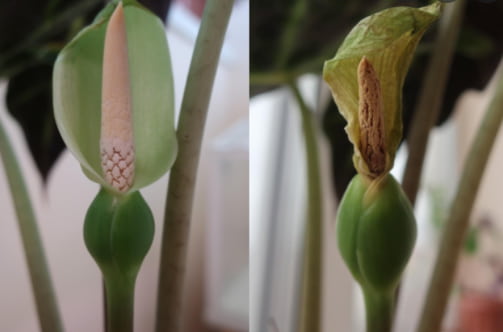
On the other hand, in Colocasia plants, the placenta is seen next to the inner side and the stem and the ovaries are connected with the placenta through the interior sides of the ovary. Colocasia flowers are hidden under the leaf canopy. They are large, quite attractive fragrant and yellow in color.

Growing requirements
The growing requirements of these two plants are also different in some cases.
Light – Alocasia varieties need shade to full sunlight depending on variety. If the plants grow in the more light the leaf color tends to be better.
On the other hand, Colocasia grows best in full sun exposure.
Watering – Both plants need frequent watering. Colocasia needs almost aquatic conditions with plenty of water. They can be grown in standing water.
On the other hand, Alocasia plants should be kept moist all the year round. They are water loving plants. But they require less water during the winter and they cannot be grown in standing water.
Soil – Colocasia plants like compost-rich soil. It thrives in wet soil but does not like staying wet in the wintertime. That’s why it needs compost-rich soil that does not stay wet in the wintertime.
On the other hand, Alocasia plants require loose, well-drained potting mix or crumby loamy soil. They need soil that doesn’t stay soggy. If they are planted in a very wet location for a long time it causes root rot.
Similarities
Though they have many differences they also have similarities as they are from the same family ‘Araceae’. Now we will see a bit of a primer on the features that these two plants share.
Common name – Both the plants are called elephant ear because of their very large and arrow shaped leaves.
Light – Both Alocasia and Colocasia even all elephant ear plants are shade-tolerant and they like to grow in more sunlight and moist soil.
Flower – Both plants have almost similar-looking flowers and they are all critter-resistant.
Soil – These two tropical plants prefer to stay dry when they are latent. So they need a nice soft, rich bed of compost to grow.
Fertilizer – Both plants are heavy feeders. They require liquid fertilizer during the growing season.
Food – Both Alocasia and Colocasia have edible parts for which they are specially grown in some areas.
Propagation – Both plants are propagated by the tubers. Alocasia produces rhizomes which are also used in propagation.
Final thought
Alocasia and Colocasia both are very popular plants. They are mostly grown as houseplants.
Here’s our overview on identifying the two plants. Hope this guide will clear your confusion on Alocasia vs Colocasia.
If I miss anything or have any mistakes, comment below in the comment section.
Reference: NC State Extension , Wisconsin Horticulture , Wikipedia and so on.
Would U love this? You can pin the article and share it with your friends.


![Philodendron dark lord vs majesty [ Differences & Similarities to identify]](https://diaryforgardening.com/wp-content/uploads/2022/09/Black-lord-vs-black-majesty.webp)

